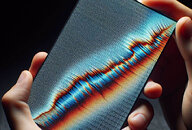- Joined
- Oct 9, 2007
- Messages
- 47,845 (7.39/day)
- Location
- Dublin, Ireland
| System Name | RBMK-1000 |
|---|---|
| Processor | AMD Ryzen 7 5700G |
| Motherboard | Gigabyte B550 AORUS Elite V2 |
| Cooling | DeepCool Gammax L240 V2 |
| Memory | 2x 16GB DDR4-3200 |
| Video Card(s) | Galax RTX 4070 Ti EX |
| Storage | Samsung 990 1TB |
| Display(s) | BenQ 1440p 60 Hz 27-inch |
| Case | Corsair Carbide 100R |
| Audio Device(s) | ASUS SupremeFX S1220A |
| Power Supply | Cooler Master MWE Gold 650W |
| Mouse | ASUS ROG Strix Impact |
| Keyboard | Gamdias Hermes E2 |
| Software | Windows 11 Pro |
OLED is the future of flat screen displays, as they provide superior color reproduction, dynamic range, response-times, and energy efficiency, over LCD. The latest crop of OLED panels powering notebooks and desktop monitors, however, have a problem that wasn't as prevalent with OLED-based televisions—burn-in. This is what happens when an OLED panel displays a static image for too long, causing regions of the panel to permanently discolor. Some PC monitor makers are jumping in to offer extended warranties against burn-in to their customers, as they realize that they just sold an expensive, exotic piece of technology that could potentially degrade within- or not long after their standard warranty periods. Scientists at the University of Cambridge think they have found a breakthrough solution against OLED burn-in.
Scientists discovered that the main culprit behind OLED burn-in is the blue diode. The blue LED has been an elusive technology that only came into existence several decades after green and red. It's only with the arrival of the blue LED that white could be made, turning LED into mankind's primary lighting source, and eventually the OLED panel. Blue is a relatively higher energy diode, and uses more exotic GaN substrate. The Cambridge scientists discovered that jacketing the blue diode alkylene straps would cut down burn-in, and make the manufacturing process more efficient. They have published their method in the Nature magazine. Unfortunately, it will be a while before display manufacturers take an interest in the new method, and re-tool their OLED production lines to incorporate it—we imagine at least a couple of years.

View at TechPowerUp Main Site | Source
Scientists discovered that the main culprit behind OLED burn-in is the blue diode. The blue LED has been an elusive technology that only came into existence several decades after green and red. It's only with the arrival of the blue LED that white could be made, turning LED into mankind's primary lighting source, and eventually the OLED panel. Blue is a relatively higher energy diode, and uses more exotic GaN substrate. The Cambridge scientists discovered that jacketing the blue diode alkylene straps would cut down burn-in, and make the manufacturing process more efficient. They have published their method in the Nature magazine. Unfortunately, it will be a while before display manufacturers take an interest in the new method, and re-tool their OLED production lines to incorporate it—we imagine at least a couple of years.

View at TechPowerUp Main Site | Source





 I might rethink my strict "no OLED" policy if this actually works.
I might rethink my strict "no OLED" policy if this actually works.